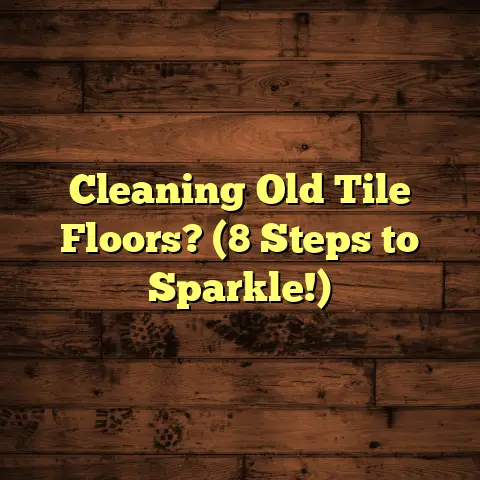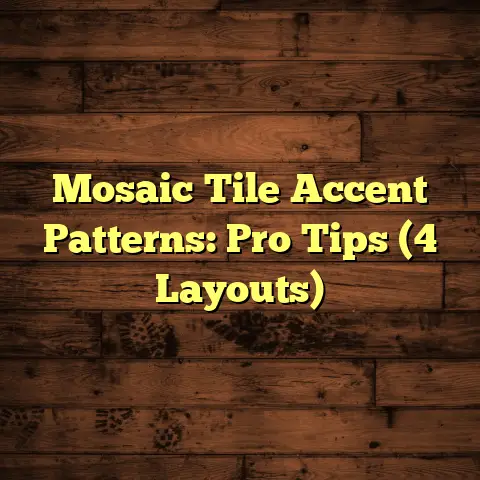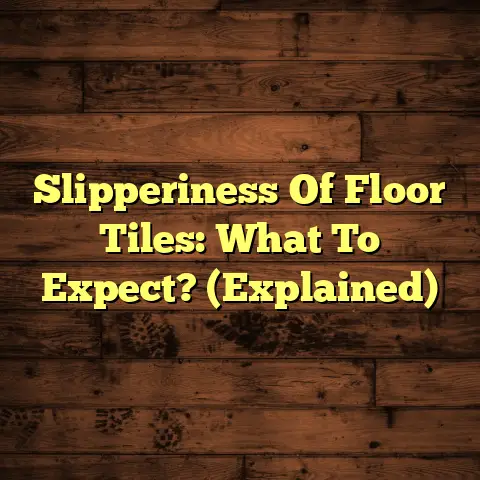Fix A Buckled Porch Floor? (4 Boards Must Go!)
I’m excited to share my knowledge and experience as a flooring contractor to help you tackle a common problem: a buckled porch floor.
I’ve seen it all, and I know how frustrating it can be when your beautiful porch starts to warp and buckle.
But don’t worry, with the right approach, you can restore your porch to its former glory.
Let’s dive in!
The Art of Craftsmanship in Flooring
Craftsmanship in flooring, especially for porches, is more than just laying down some boards.
It’s an art form.
It’s about selecting the right materials that can withstand the elements, precisely cutting each piece to fit perfectly, and paying attention to every little detail.
I still remember my grandfather, a master carpenter, teaching me the importance of grain direction and proper sealing.
He’d say, “A well-crafted floor isn’t just pretty; it’s a legacy!”
And he was right.
A well-crafted porch floor enhances your home’s exterior and becomes a gathering place for family and friends.
Think about those summer evenings, grilling out, laughing, and making memories on your porch.
That’s what it’s all about, right?
Section 1: Understanding Buckling in Porch Floors
So, what exactly is buckling?
In simple terms, it’s when your porch boards lift or warp, creating an uneven surface.
It’s not just unsightly; it can also be a tripping hazard.
Common Causes of Buckling
Buckling is often caused by a few key factors:
-
Moisture Issues: This is the big one. Wood expands when it absorbs moisture and contracts when it dries out. If the wood absorbs too much moisture, it can push against neighboring boards, causing them to buckle.
-
Temperature Fluctuations: Extreme temperature changes can also cause wood to expand and contract, leading to buckling over time.
-
Poor Installation: Improper spacing between boards, inadequate sealing, or using the wrong type of fasteners can all contribute to buckling. I can’t tell you how many times I’ve seen floors buckle simply because the installer didn’t leave enough room for expansion!
Different materials have different vulnerabilities.
For example, wood is highly susceptible to moisture, while composite decking is more resistant but can still buckle if not installed correctly.
According to the Forest Products Laboratory, wood can expand up to 5% in width when exposed to high humidity. Source: (https://www.fpl.fs.fed.us/)
Section 2: Identifying the Problem
Okay, so you suspect your porch floor is buckling.
Let’s get down to inspecting it.
Signs of Buckling
Here’s what to look for:
-
Visible Lifting: This is the most obvious sign. Boards will appear to be raised or warped.
-
Uneven Surface: Run your hand across the floor. Do you feel any bumps or dips?
-
Cracks: Buckling can cause cracks in the boards, especially near the fasteners.
-
Squeaking: As boards rub against each other, they can start to squeak when you walk on them.
Assessing the Damage
Not all warping is created equal.
Minor warping might just be a cosmetic issue, but severe buckling can indicate a more serious problem, like rot or structural damage.
Poke around with a screwdriver.
If the wood feels soft or spongy, it’s likely rotting and needs to be addressed immediately.
To determine which boards need to be replaced, I usually use a simple test:
If the board is lifting more than ¼ inch, or if it’s severely cracked or rotted, it’s time to replace it.
Section 3: Tools and Materials Needed for Repair
Alright, let’s gear up!
Here’s a list of tools and materials you’ll need:
Tools
-
Pry Bar: For gently lifting the damaged boards. I prefer a flat pry bar with a wide head to minimize damage to surrounding boards.
-
Hammer: To tap the pry bar and secure fasteners.
-
Circular Saw or Hand Saw: For cutting the replacement boards.
-
Measuring Tape: Precision is key!
-
Screwdriver or Drill: Depending on the type of fasteners used.
-
Safety Glasses: Protect your eyes!
-
Gloves: Protect your hands!
Materials
-
Replacement Boards: Choose the same type of wood or composite as your existing porch floor.
-
Wood Glue: For added stability.
-
Nails or Screws: Use the same type of fasteners that were originally used.
-
Sealant: To protect the new boards from moisture.
-
Stain or Paint: To match the existing finish.
Selecting the Right Materials
Matching the existing porch flooring is crucial for a cohesive look.
If you’re using wood, make sure to choose the same species and grade.
For example, if your porch is made of pressure-treated pine, use pressure-treated pine for the replacement boards.
If you’re using composite decking, choose the same brand and color.
I always recommend buying a little extra material, just in case you make a mistake or need to replace more boards than you initially thought.
Section 4: Step-by-Step Guide to Fixing the Buckled Porch Floor
Now for the fun part!
Let’s get those buckled boards out and replace them with fresh ones.
Step 1: Preparing the Work Area
First, clear the area.
Remove any furniture, planters, or other obstacles.
This will give you plenty of room to work and prevent any accidents.
Make sure you have good lighting, and consider setting up a fan if it’s a hot day.
Safety first!
Step 2: Carefully Prying Up the Damaged Boards
This is where the pry bar comes in handy.
Gently insert the pry bar under the edge of the damaged board and slowly lift.
Be careful not to damage the surrounding boards.
If the board is nailed down, you may need to use a hammer to tap the pry bar further underneath.
Work your way along the board, lifting it gradually until it’s free.
Sometimes, the nails or screws will be stubborn.
If that’s the case, use a nail puller or a screw extractor to remove them.
Step 3: Assessing the Joists and Subfloor
Once the damaged boards are removed, take a good look at the joists and subfloor underneath.
Are they rotted or damaged?
If so, you’ll need to repair or replace them before installing the new boards.
Use a screwdriver to poke around and check for soft spots.
If you find any rot, scrape it away and treat the area with a wood preservative.
If the damage is extensive, you may need to call in a professional.
Step 4: Measuring and Cutting New Boards
Measure the space where the old board was located.
Be precise!
Cut the new board to the exact length, using a circular saw or hand saw.
I always recommend measuring twice and cutting once.
It’s better to be slightly too long than too short.
You can always trim a little off, but you can’t add it back on!
Step 5: Installing the New Boards
Apply a bead of wood glue to the joists.
This will help to secure the new board and prevent squeaking.
Position the new board in place and press down firmly.
Using the same type of fasteners as before, nail or screw the board to the joists.
Make sure the fasteners are flush with the surface of the board.
If they’re sticking out, they can be a tripping hazard.
Step 6: Finishing the Surface
Once the new board is installed, it’s time to finish the surface.
Sand the board smooth, using a medium-grit sandpaper.
This will help to blend it in with the surrounding boards.
Apply a sealant to protect the wood from moisture.
Finally, stain or paint the board to match the rest of the porch.
I usually apply two coats of stain or paint for added protection.
Section 5: Preventing Future Buckling
Now that you’ve fixed your buckled porch floor, let’s talk about prevention.
Here are some tips to minimize the risk of future buckling:
-
Proper Ventilation: Make sure your porch has adequate ventilation. This will help to prevent moisture buildup.
-
Moisture Control: Keep your porch clean and dry. Sweep up any leaves or debris that can trap moisture.
-
Regular Maintenance: Inspect your porch floor regularly for signs of damage. Address any issues promptly before they become major problems.
-
Proper Spacing: When installing new boards, leave a small gap between them to allow for expansion and contraction.
-
Sealant: Apply a high-quality sealant to protect the wood from moisture.
I recommend resealing your porch floor every year or two, depending on the climate.
Conclusion
There you have it!
You’ve successfully fixed your buckled porch floor.
Give yourself a pat on the back!
Restoring a buckled porch floor is a rewarding experience.
It’s a testament to your skills and dedication to home improvement.
With the right tools, materials, and techniques, you can reclaim your outdoor spaces and preserve the craftsmanship that makes your home unique.
And there’s nothing quite like the satisfaction of completing a DIY project and knowing that you did it yourself.
Now, go enjoy your beautiful, restored porch!
Happy DIY-ing!





